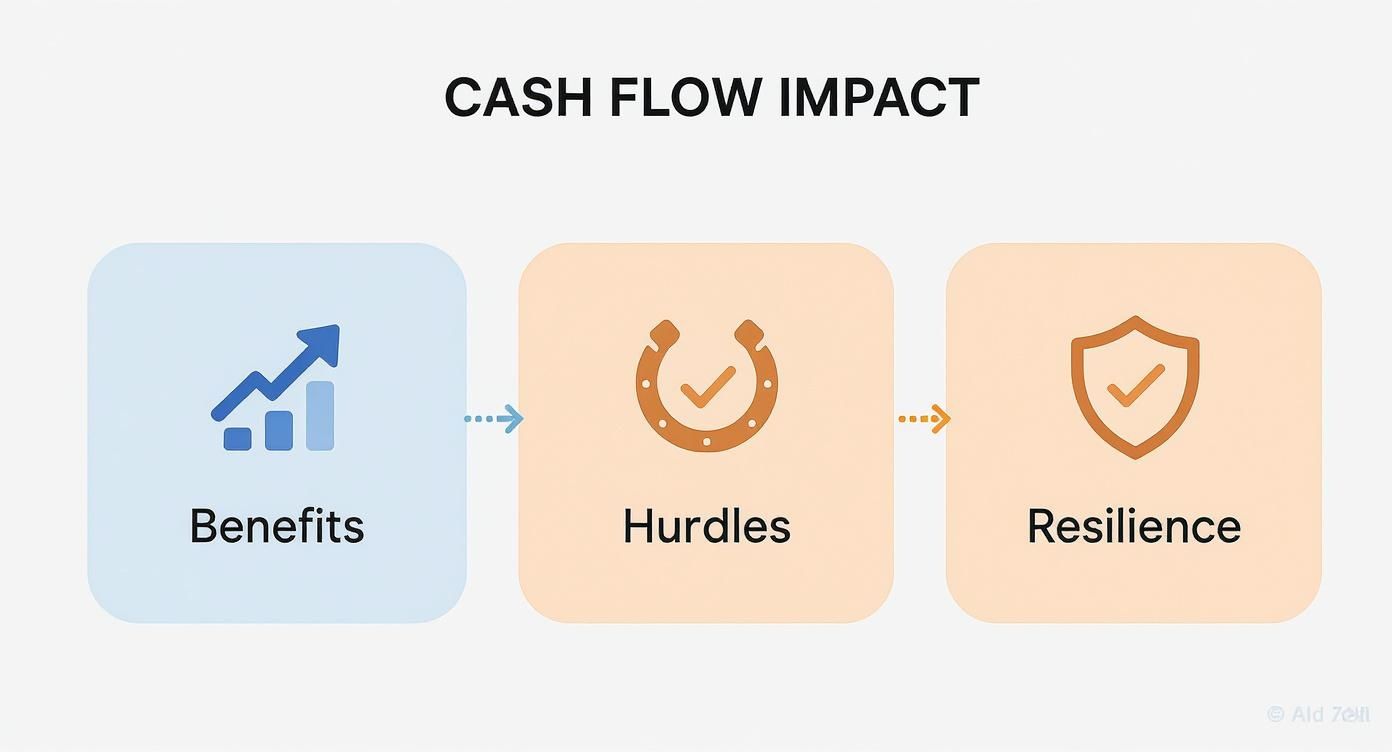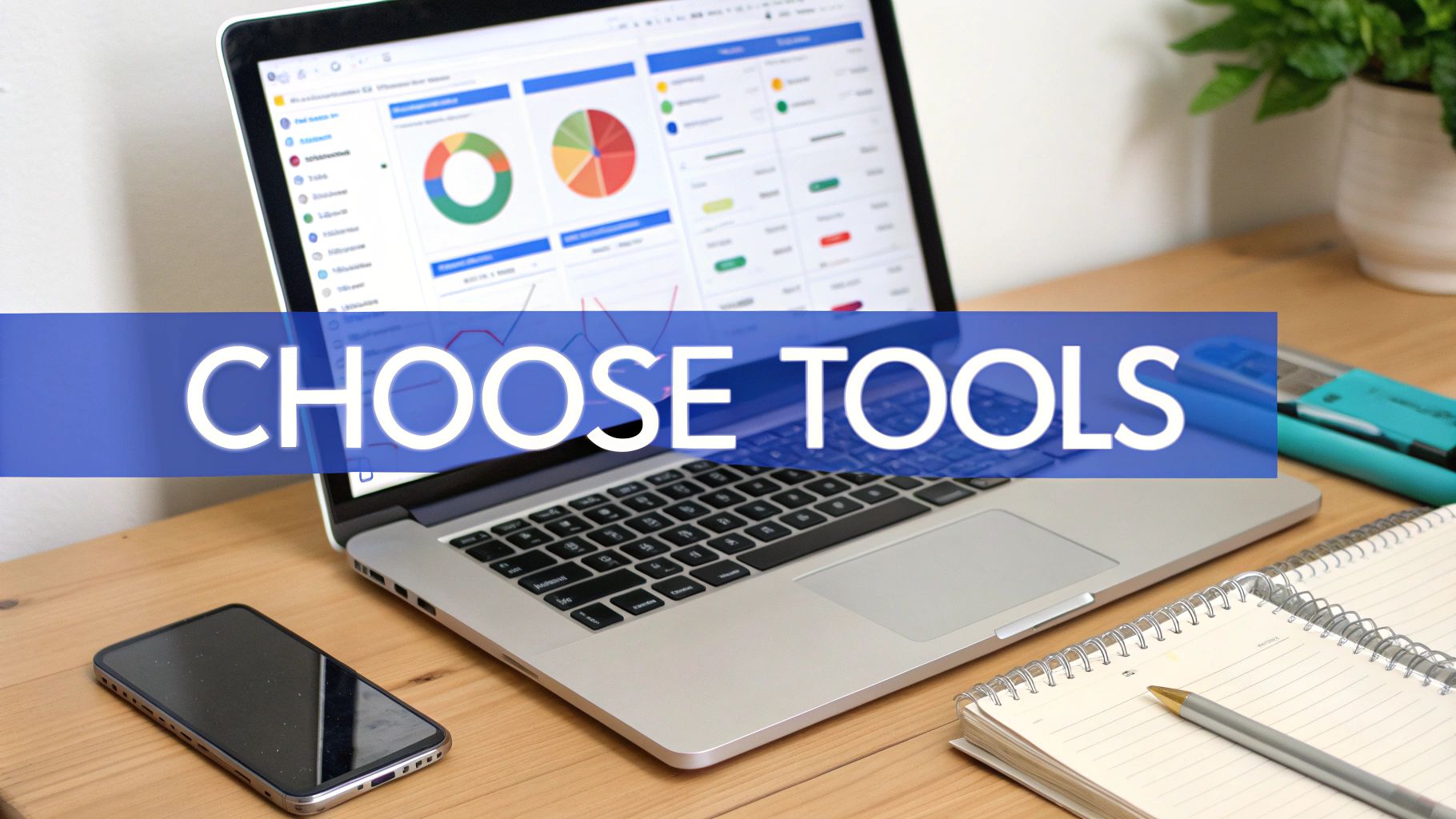Our Marketing Team at PopaDex
What Is Cash Flow Management A Practical Guide

In simple terms, cash flow management is the art and science of watching, analyzing, and fine-tuning the money that moves into and out of your business. It’s all about making sure you have enough cash on hand to pay your bills, handle your debts, and fund your growth—without hitting a shortfall, even when you look profitable on paper.
Why Cash Flow Management Is Your Business Lifeline

Think of cash as the lifeblood of your business. If that’s the case, then cash flow management is the circulatory system that keeps it all pumping smoothly.
Without a steady, healthy flow, every other part of your company—from payroll to production—can grind to a sudden halt. This goes beyond dodging bankruptcy; it’s about building a business that’s both resilient and ready to move fast.
So many businesses make the classic mistake of confusing profit with cash. But the reality is, a company can be wildly profitable and still go under because it ran out of money. This happens when cash gets trapped in unpaid customer invoices or tied up in too much inventory, leaving nothing liquid to pay suppliers or staff.
This very distinction is why you can’t afford to be passive.
The Foundation of Financial Stability
To truly get why this is your lifeline, you need to understand the crucial importance of profitability and cashflow. A proactive approach moves you from just reacting to financial fires to strategically planning for what’s ahead.
Effective cash flow management is the discipline of maintaining a healthy balance between your cash inflows (money received) and cash outflows (money spent) over a specific period. It is the tactical execution of your financial strategy.
Getting a handle on this strategic oversight brings some serious advantages that help your business do more than just survive—they help it thrive.
To give you a clearer picture, here are the essential activities involved in managing your cash flow.
Core Components of Cash Flow Management
| Component | What It Means for Your Business | | :— | :— | | Cash Flow Forecasting | Predicting future cash inflows and outflows to anticipate potential shortfalls or surpluses. | | Accounts Receivable Management | Actively collecting money owed by customers to speed up cash coming into the business. | | Accounts Payable Management | Strategically managing when you pay your bills to suppliers to hold onto cash longer. | | Inventory Control | Optimizing inventory levels to avoid tying up too much cash in products sitting on a shelf. | | Financing and Investing | Securing loans when needed and investing surplus cash wisely to generate returns. |
Mastering these components transforms how you operate, turning financial management from a chore into a competitive edge.
This strategic oversight gives you several key advantages:
- Improved Decision-Making: With a clear view of your cash position, you can make smart, confident calls on hiring, expansion, and big investments.
- Enhanced Liquidity: It ensures you can meet your short-term bills, like payroll and rent, without breaking a sweat or needing last-minute loans.
- Increased Investor Confidence: A business with its cash flow dialed in looks stable and less risky, making it far more attractive to lenders and investors.
- Greater Operational Freedom: Having cash ready to go means you can jump on opportunities as they appear, like snapping up a bulk discount or making a strategic acquisition.
Decoding Your Business’s Financial Pulse

At its heart, cash flow management is just a fancy term for tracking the money coming into and going out of your business. It’s the financial equivalent of monitoring your heart rate.
Think of it like this: you have cash inflows—the money you receive from sales, loans, or investments—and cash outflows, which cover things like rent, payroll, and supplies. The goal is to make sure you have more coming in than going out.
Keeping an eye on every invoice you get paid and every bill you send out is the first step. This simple act gives you a clear, real-time picture of your company’s liquidity.
Let’s break that down:
- Sales Revenue is like a steady river filling your financial reservoir.
- Loan Proceeds are like a sudden downpour, boosting your water levels quickly.
- Operational Costs are the pipes that draw water out for daily needs.
- Capital Purchases are massive drains—like opening a dam—that require careful planning.
Measuring Liquidity
So, how do you know if you’re in good shape? You look at your net cash position, which is just your inflows minus your outflows over a certain period.
This number tells you if your financial reservoir is filling up or draining away. Staying on top of this is non-negotiable—it’s how you make payroll and handle those surprise expenses that always pop up.
| Metric Name | What It Tells You |
|---|---|
| Operating Cash | The cash generated from your core business activities. |
| Free Cash Flow | The money left over after you’ve paid for everything needed to run and grow the business. |
Applying the Reservoir Analogy
Imagine your business’s cash is the water supply for a small town. The streams feeding the reservoir are your sales, while the pipes going out to homes and businesses represent your expenses.
If everyone turns on their taps at once without enough rain, the water level plummets. Your business works the same way. A sudden spike in expenses without a corresponding rise in income can leave you dangerously dry.
In the bigger picture, businesses are holding onto more cash than ever. Money market fund balances jumped from $5.87 trillion to $6.75 trillion—an almost 15% spike. This trend highlights just how critical cash reserves are becoming.
Healthy cash reserves act like a buffer against financial droughts, giving you room to maneuver when sales slow down or unexpected costs hit.
The financial world is also speeding up. It’s worth exploring the impact of real-time payments on financial planning to see how these shifts can affect your cash flow strategy.
The best way to get a handle on this is to see it visually. Simple dashboards that chart your inflows and outflows side-by-side make it incredibly easy to spot trends before they become problems.
This is where a tool like PopaDex comes in handy. You can integrate all your accounts and see your net position at a glance. Check out our guide on how to https://popadex.com/Track-Cash-Flow/ to get started.
Once you have this visual foundation, you can start forecasting your cash needs and even set up alerts for when your balance dips below a certain point. This is how you turn raw data into a real, actionable strategy.
Next Steps
Ready to put this into practice? Start by scheduling weekly cash flow reviews. It might sound tedious, but it’s a game-changer.
Set up alerts to ping you when your “reservoir” gets too low. Then, start playing with “what-if” scenarios. What happens if sales suddenly drop by 20%? Running these drills builds confidence and makes your forecasts much more reliable.
Regular reviews keep your data fresh and your insights sharp. Using PopaDex dashboards can automate the alerts, so you spot issues long before they turn into emergencies. There’s no reason to wait—you can get started today.
The Real-World Impact of Strong Cash Flow Management
Knowing the textbook definition of cash flow is one thing, but seeing what it can do for a business in the real world? That’s what really matters. Great cash management goes beyond dodging financial bullets; it’s about building a business that’s nimble, tough, and always ready to jump on a great opportunity.
When your cash flow is under control, making big decisions becomes a whole lot clearer and less stressful. You can confidently invest in that new piece of equipment, hire that A-player you’ve been eyeing, or launch a bold marketing campaign without lying awake at night wondering if you’ll make payroll. That freedom is a massive competitive advantage.
Benefits in Action and Hurdles to Overcome
The practical benefits show up everywhere. For instance, a healthy cash position gives you leverage to negotiate better terms with suppliers—maybe you can snag a discount for paying early. That small win directly lowers your costs and pads your profit margins.
On the flip side, the hurdles can be brutal. Many businesses wrestle with unpredictable sales cycles, seasonal slumps, or a sudden, massive expense that wipes out their reserves. I’ve seen profitable companies on paper nearly go under because a few major clients paid their invoices late, all at the same time. It’s a timing crisis.
The core challenge of cash flow management isn’t just about having money. It’s about having it at the right time. A healthy bank balance means very little if you can’t get to it when a critical bill is due.
This is exactly why you can’t afford to just react. Proactive planning is non-negotiable if you want to be around for the long haul. A business that meticulously manages its cash can ride out an economic storm, while one that’s always playing catch-up might be forced into taking on expensive, last-ditch loans.
Navigating an Unpredictable Landscape
In today’s volatile economy, managing liquidity has shot to the top of the priority list. Cash flow is now seen as a major risk factor globally, with one recent survey placing liquidity risk in the top 10 for the first time since 2019. And here’s the kicker: even though 81% of organizations said they were planning for this risk, nearly a third still took a hit from cash-related losses. You can dive into the full study on global financial risks at Aon.com.
This data tells a crucial story: having a plan is a great start, but that plan has to be tough enough to handle reality. Here’s how strong cash flow management really makes a difference:
- Thriving in a Downturn: A company with cash in the bank can not only keep the lights on during a recession but might even be able to acquire struggling competitors.
- Seizing Growth Opportunities: When a golden opportunity appears—like a chance to buy inventory in bulk at a steep discount—having cash on hand means you can say “yes” immediately.
- Reducing Financial Stress: Simply knowing you can cover your bills removes a huge weight from a business owner’s shoulders, freeing you up to focus on the big picture.
Ultimately, mastering your cash flow transforms your business from something fragile and at the mercy of the market into a resilient organization built for sustainable growth.
Proven Methods for Optimizing Your Cash Flow
If you’re ready to move past basic budgeting and get serious about financial agility, you’re in the right place. Let’s dig into a few dynamic strategies that will keep your cash flowing smoothly and your business ready for whatever comes next.
We’re not just talking about tracking what you’ve spent. We’ll explore forward-looking tactics like rolling forecasts, scenario planning, and real-time dashboards that give you a true command center for your finances.
Rolling Forecasts and Scenario Planning
Static annual budgets are a relic of the past. Today’s most resilient businesses use a combination of rolling forecasts and scenario planning. Think of it this way: a rolling forecast is like updating your GPS route in real-time as road conditions change, rather than sticking to the original printed map.
It works by continuously extending your financial outlook. When one month or quarter ends, you simply add a new one to the end of your forecast. This keeps your planning window consistent and always forward-looking.
Scenario planning, on the other hand, is your financial “what if” game. It’s where you model potential events—both good and bad—before they happen. What if a huge new client signs on? What if a key supplier raises prices by 20%?
Here’s a simple framework to get started:
- Update your forecast weekly. This frequency helps you spot trends early and react before they become problems.
- Create three core scenarios: an optimistic case (best-case), a realistic case (most likely), and a conservative one (worst-case).
- Regularly compare your predictions against what actually happened. This is crucial for refining your assumptions and getting more accurate over time.
“Effective scenario planning helps you maneuver through uncertainty with confidence,” notes CFO expert Maria Lopez.
Comparing Modern Cash Flow Forecasting Methods
Not all forecasting methods are created equal. The right one for you depends on your business complexity, the data you have available, and how far into the future you need to see. Here’s a quick breakdown of the most common approaches to help you find the best fit.
| Method | Best For | Key Advantage | Potential Drawback |
|---|---|---|---|
| Direct Forecast | Short-term views (weeks to months) and businesses with predictable cycles. | Simple to set up and understand, based on actual payables and receivables. | Loses accuracy quickly over longer periods; can miss bigger trends. |
| Rolling Forecast | Dynamic businesses needing continuous, up-to-date financial planning. | Highly adaptive and forward-looking, avoids the “set it and forget it” trap. | Requires a consistent commitment to updating data and assumptions. |
| Driver-Based Forecast | Businesses where specific operational metrics directly impact revenue. | Creates a detailed link between operations (e.g., website traffic) and financials. | Can be complex to build and maintain the underlying models. |
| AI-Assisted Forecast | Companies with large, complex datasets looking for predictive insights. | Uncovers hidden patterns and delivers a high degree of predictive accuracy. | Requires clean data and can be a “black box” if not properly understood. |
Choosing a method is just the first step. To keep the process from falling apart, make sure you assign clear roles for who owns the forecast and set a non-negotiable review cadence—at least once a month.
Technology has completely changed the game here. Thanks to API-based bank connectivity and AI-powered tools, companies are shifting from a reactive mindset (just controlling cash) to a proactive one (predicting liquidity). You can learn more about where the industry is headed by reading up on the cash management trends of 2025.
Visualizing Key Data
A forecast is only useful if you can understand it at a glance. Visuals are key. The infographic below maps out the core components of cash flow management, showing how proactive planning builds resilience while neglect creates risk.

This map is more than a pretty picture; it tells a story. The upward arrows represent benefits like improved decision-making, while the barrier icons highlight common hurdles like inaccurate data. The shields symbolize the resilience you build through smart management.
The data backs this up: studies show that proactive planning can boost a company’s financial resilience by as much as 45%, while a hands-off approach can increase risk factors by 30%.
Best Practices for Working Capital
Your working capital—the money tied up in day-to-day operations—is a huge lever for improving cash flow. The goal is simple: speed up the cash coming in and be strategic about the cash going out.
Here are a few proven tactics:
- Incentivize early payments. Offer a small discount (like 2%) to customers who pay their invoices well before the due date.
- Manage your payables strategically. You don’t have to pay every bill the moment it arrives. Schedule payments closer to their due dates to hold onto your cash longer (without ever being late, of course).
- Keep a close eye on inventory. Every product sitting on a shelf is trapped cash. Monitor your inventory turnover rates to make sure you’re not overstocked.
PopaDex in Action
This is where a dedicated tool can make all the difference. Instead of wrestling with spreadsheets, a platform like PopaDex brings all your cash flow data into one clear view.

Our dashboard consolidates your real-time bank balances, forecast projections, and custom alerts. You can instantly see where you stand, toggle between different scenarios you’ve built, and get automated notifications if your cash balance is projected to dip below a level you’ve set.
For a deeper dive into the mechanics of these forecasting models, check out our complete guide on budget forecasting methods. You’ll get a detailed comparison of rolling vs. direct forecasting and more.
Don’t wait for a cash crunch to take action. Start putting these strategies into practice today and build a more financially resilient business.
Choosing the Right Tools for Your Business

The right technology can turn cash flow management from a painful chore into a genuine strategic advantage. It’s the difference between reacting to financial problems and proactively steering clear of them.
The market for these tools is crowded, running the gamut from free spreadsheet templates to massive, enterprise-grade software suites. Understanding the trade-offs is key to making a smart choice—one that doesn’t have you overpaying for features you’ll never use or, worse, getting stuck with a tool you outgrow in six months.
Tools for Every Business Size
Startups and small businesses often begin with manual templates. It makes sense at first. But as the business grows and transactions become more complex, those simple spreadsheets can quickly become a liability.
At the other end of the spectrum, large enterprise teams need powerful platforms with heavy-duty automation, sophisticated analytics, and the ability to scale globally.
- Spreadsheet Templates: The go-to for a zero-cost start. Perfect for solo entrepreneurs or small teams with very basic financial tracking needs.
- Mid-Market Solutions: These platforms bring in real-time data visualization, handle multiple currencies, and often integrate with other business software.
- Enterprise Platforms: Built for scale, they offer deep API integrations, advanced custom reporting, and granular user permissions for large, complex teams.
When you’re comparing options, zero in on the features that will directly impact your cash position and daily workflow. Look for real-time dashboards, automated reporting, and forecasting models to help you stay ahead of potential shortfalls.
| Feature | Why It Matters |
|---|---|
| Real-time Data | Gives you the power to react instantly to unexpected cash dips. |
| Multi-Currency | Essential for managing global sales and expenses without headaches. |
| Automated Alerts | Prevents missed payments and helps you avoid overdraft fees. |
Selecting Based on Your Workflow
For a lean startup, a flexible template that allows for manual entry is often more than enough. The main priority for small teams is a simple, clean dashboard that anyone can understand and update without a finance degree.
As you grow into the mid-market, you’ll feel the pain of siloed data. This is where tools that connect your sales, inventory, and accounting systems become invaluable. That integration cuts down on tedious manual reconciliation and makes your cash forecasts dramatically more accurate.
Global enterprises have another layer of complexity. They absolutely require multi-currency handling, role-based security to control who sees what, and advanced reporting to ensure compliance and maintain visibility across different countries and business units.
How PopaDex Stands Out
PopaDex was built to give you a single, unified view of your cash. It combines an intuitive dashboard, predictive analytics, and seamless integrations to pull all your financial data into one place.
Our platform connects to over 15,000+ banks in 30 countries, so your data is always pulled in real time. No more waiting for month-end reports to see where you stand. You can also set custom alerts that notify you before your balances drop below a certain threshold.
“PopaDex gave us instant clarity on our cash position and cut reconciling time in half,” says CFO Jenna Morales.
Getting started is a straightforward process:
- Assess Your Needs: First, map out your current cash management process and identify the biggest pain points. Where are the bottlenecks? What takes the most time?
- Trial Core Features: Don’t just watch a demo. Get your hands on the software and see how it handles your specific, real-world scenarios.
- Integrate Smoothly: Make sure the tool connects easily with your existing accounting software and banking APIs. A difficult integration can kill a project before it starts.
Ultimately, you need a tool that aligns with your company’s size, industry, and growth plans. For more ideas, you might find our guide on financial management tools helpful in narrowing down your options.
Evaluating Cost and ROI
Of course, the cost has to make sense for your budget and deliver real benefits. Look beyond the sticker price and consider the total cost of ownership, which includes licensing fees, implementation time, and any ongoing support costs.
To figure out the return on investment (ROI), try to put a dollar value on the improvements. Map out the time your team will save, the potential reduction in costly errors, and the value of having more accurate forecasts. Document these projected savings and use them to compare vendors before you sign on the dotted line.
A free trial period is your best friend here—it can reveal hidden limitations or maintenance headaches that you’d never spot in a sales presentation.
Weaving a Stronger Financial Safety Net
Good cash flow management goes beyond dodging financial bullets; it’s the very foundation of a business built to last. We’ve walked through the essentials, from taking your company’s financial pulse to putting proven strategies into action. This journey is about shifting from just counting money to actually steering your company’s future.
The biggest change you’ll make is moving from a reactive to a proactive stance. Instead of scrambling when a surprise bill lands, you start seeing market changes on the horizon, playing out different financial what-ifs, and making big decisions with real confidence. This is what separates the businesses that just get by from the ones that truly lead the pack.
The real goal of mastering cash flow is to buy yourself freedom. It’s the freedom to invest, to try new things, and to grow without constantly looking over your shoulder for liquidity problems. That stability becomes your secret weapon.
By getting serious about forecasting, using modern tools for a live look at your finances, and always tweaking your approach, you build a financial base that can withstand anything. This empowers your business not just to ride out the tough times but to jump on new opportunities with speed and certainty, securing a stronger tomorrow.
Cash Flow Management FAQs
To wrap this up, let’s tackle a few common questions business owners ask when they first start getting serious about cash flow. Think of this as the practical advice you need to move from theory to action.
What Are The Most Important Cash Flow Metrics To Track?
Don’t get lost in the weeds. For a clear, actionable view of your financial health, just focus on three core metrics.
First is Operating Cash Flow (OCF). This is the pure cash your main business activities generate. It tells you if your core model is actually working day-to-day.
Next, keep an eye on your Free Cash Flow (FCF). This is what’s left over after you’ve paid for everything needed to run and grow the business. It’s your “free” money for paying down debt, expanding, or rewarding shareholders.
Finally, monitor your Cash Conversion Cycle (CCC). This metric tracks how long it takes to turn your investment in inventory back into cash in your pocket. A shorter cycle is always better—it means you get your money back faster.
How Can A Small Business Start Cash Flow Forecasting?
You don’t need fancy, expensive software to get started. Seriously. Just open a simple spreadsheet.
Project your incoming cash (sales, loans) and outgoing cash (rent, payroll, supplies) for the next 30-60 days. Update it every week. This basic “direct” forecasting method gives you a surprisingly clear picture of potential cash crunches, letting you act before they become emergencies.
The goal of a starter forecast is not perfect accuracy but directional guidance. It’s about spotting potential problems while you still have time to act, turning reactive panic into proactive planning.
This one simple habit builds a rock-solid foundation for more sophisticated financial management down the road.
Can New Tools Integrate With My Existing Accounting Software?
Yes, and this is where things get really powerful. Modern cash flow management platforms are built to connect seamlessly with the tools you already use.
They use secure connections (APIs) to talk directly to accounting software like QuickBooks and Xero, as well as your main bank accounts.
This kind of automation is a game-changer. It gets rid of tedious data entry, slashes the risk of human error, and gives you a real-time, consolidated dashboard of your entire cash position. No more logging into five different systems to know where you stand.
Ready to gain real-time clarity and confidence in your financial journey? With PopaDex, you can consolidate and monitor your entire financial portfolio in one intuitive dashboard. Start your free trial today and see your full financial picture.